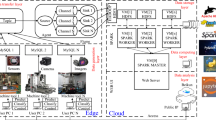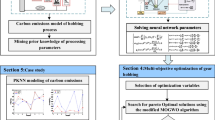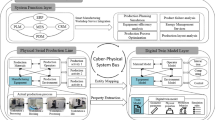Abstract
The transformation of manufacturing industry to green manufacturing is one of the important tasks to achieve the carbon peaking and carbon neutrality goals, which needs to improve the use efficiency of unit carbon emission. In order to describe the processing state in real time and improve the accuracy of carbon emission prediction, a dynamic prediction and simulation model of carbon efficiency based on digital twin was proposed. First, the dynamic characteristics of carbon emission during hobbing process was analyzed, and three carbon efficiency targets were defined to assess carbon emissions from processing processes. Then, a dynamic prediction and simulation model of carbon emissions was constructed based on convolutional neural network and dynamic discrete event system specification. On this basis, the framework of the carbon efficiency digital twin (CEDT) of the hobbing process was built, and the dynamic prediction and simulation models were integrated into CEDT as virtual models. The application in hobbing process showed that the presented model has higher accuracy in carbon emission prediction. The root-mean-square error, mean absolute error, and mean absolute percentage error of the real-time power prediction were reduced by 43.98%, 34.55%, and 30.67% on average, compared with the traditional method. Meanwhile, the validity of CEDT was verified and the effect of dynamic parameters on carbon efficiency was discussed.

















Similar content being viewed by others
Availability of data and material
My manuscript has data included as electronic supplementary material.
Code availability
Not applicable
References
Communist Party of China Central Committee and the State Council (2021) Working guidance for carbon dioxide peaking and carbon neutrality in full and faithful implementation of the new development philosophy. People’s Daily. https://doi.org/10.28655/n.cnki.nrmrb.2021.011159
Papetti A, Menghi R, Domizio GD, Germani M, Marconi M (2019) Resources value mapping: a method to assess the resource efficiency of manufacturing systems. Appl Energy 249:326–342. https://doi.org/10.1016/j.apenergy.2019.04.158
Gao P, Yue SJ, Chen HT (2021) Carbon emission efficiency of China’s industry sectors: from the perspective of embodied carbon emissions. J Clean Prod 283:124655. https://doi.org/10.1016/j.jclepro.2020.124655
Sun W, Huang CC (2022) Predictions of carbon emission intensity based on factor analysis and an improved extreme learning machine from the perspective of carbon emission efficiency. J Clean Prod 338:130414. https://doi.org/10.1016/j.jclepro.2022.130414
Sun SL, Wang SL, Wang YW, Lim TC, Yang Y (2018) Prediction and optimization of hobbing gear geometric deviations. Mech Mach Theory 120:288–301. https://doi.org/10.1016/j.mechmachtheory.2017.09.002
Xiao QG, Li CB, Tang Y, Pan J, Yu J, Chen XZ (2019) Multi-component energy modeling and optimization for sustainable dry gear hobbing. Energy 187:115911. https://doi.org/10.1016/j.energy.2019.115911
Li CB, Fu S, Chen XZ, Ji QQ (2020) Multi-objective CNC gear hobbing parameters optimization model for high efficiency and energy saving. Comput Integr Manuf Syst 26:676–687. https://doi.org/10.13196/j.cims.2020.03.011
Ni HX, Yan CP, Cao WD, Liu YF (2020) A novel parameter decision approach in hobbing process for minimizing carbon footprint and processing time. Int J Adv Manuf Technol 111:3045–3419. https://doi.org/10.1007/s00170-020-06103-1
Ni HX, Yan CP, Ge WW, Ni SF, Sun H (2022) Xu T (2020) Integrated optimization of cutting parameters and hob parameters for energy-conscious gear hobbing. Int J Adv Manuf Technol 118:1609–1626. https://doi.org/10.1007/s00170-021-07804-x
Cao WD, Ni JJ, Jiang BY, Ye CQ (2021) A three-stage parameter prediction approach for low-carbon gear hobbing. J Clean Prod 289:125777. https://doi.org/10.1016/j.jclepro.2020.125777
Yi Q, Liu C, Li CB, Yi SP, He S (2022) A low carbon optimization decision method for gear hobbing process parameters driven by small sample data. China Mech Eng 33:1604–1612. https://doi.org/10.3969/j.issn.1004-132X.2022.13.011
Kharka V, Jain NK, Gupta K (2020) Influence of MQL and hobbing parameters on microgeometry deviations and flank roughness of spur gears manufactured by MQL assisted hobbing. J Mater Res Technol 9:9646–9656. https://doi.org/10.1016/j.jmrt.2020.06.085
Liu YF, Yan CP, Ni HX (2022) The approach to multi-objective optimization for process parameters of dry hobbing under carbon quota policy. Int J Adv Manuf Technol 121:6073–6094. https://doi.org/10.1007/s00170-022-09669-0
Zhang XW, Yu TB, Dai YX, Qu S, Zhao J (2020) Energy consumption considering tool wear and optimization of cutting parameters in micro milling process. Int J Mech Sci 178:105628. https://doi.org/10.1016/j.ijmecsci.2020.105628
Han C, Luo M, Zhang DH (2020) Optimization of varying-parameter drilling for multi-hole parts using metaheuristic algorithm coupled with self-adaptive penalty method. Appl Soft Comput 95:106489. https://doi.org/10.1016/j.asoc.2020.106489
Wang JK, Qiao F, Zhao F, Sutherland JW (2016) Batch scheduling for minimal energy consumption and tardiness under uncertainties: a heat treatment application. CIRP Ann-Manuf Technol 65:17–20. https://doi.org/10.1016/j.cirp.2016.04.115
Zhu S, Zhang H, Jiang ZG, Cao HJ (2018) Multi-granularity dynamic model establishment and simulation of carbon emissions for machining process based on DEVS. Aust J Mech Eng 54:158. https://doi.org/10.3901/JME.2018.19.158
Tuo JB, Liu PJ, Liu F (2019) Dynamic acquisition and real-time distribution of carbon emission for machining through mining energy data. IEEE Access 7:78963–78975. https://doi.org/10.1109/ACCESS.2019.2919564
Alzalab EA, El-Sherbeeny AM, El-Meligy MA, Rauf HT (2021) Trust-based petri net model for fault detection and treatment in automated manufacturing systems. IEEE Access 9:157997-158009. https://doi.org/10.1109/ACCESS.2021.3128206.
Kim BS, Kim TG, Choi SH (2022) CoDEVS: an extension of DEVS for integration of simulation and machine learning. Int J Simu Model 20:661–671. https://doi.org/10.2507/IJSIMM20-4-576
Tsinarakis G, Sarantinoudis N, Arampatzis G (2022) A discrete process modelling and simulation methodology for industrial systems within the concept of digital twins. Appl Sci 12:870. https://doi.org/10.3390/app12020870
Li HC, Yang D, Cao HJ, Ge WW, Chen EH, Wen XH, Li CB (2021) Data-driven hybrid petri-net based energy consumption behaviour modelling for digital twin of energy-efficient manufacturing system. Energy 239:122178. https://doi.org/10.1016/j.energy.2021.122178
Lechevalier D, Shin SJ, Rachuri S, Foufou S, Lee YT, Bouras A (2019) Simulating a virtual machining model in an agent-based model for advanced analytics. J Intell Manuf 30:1937–1955. https://doi.org/10.1007/s10845-017-1363-x
Cao HJ, Li HC (2014) Simulation-based approach to modeling the carbon emissions dynamic characteristics of manufacturing system considering disturbances. J Clean Prod 64:572–580. https://doi.org/10.1016/j.jclepro.2013.10.002
Tao F, Zhang M, Cheng JF, Qi QL (2017) Digital twin workshop: a new paradigm for future workshop. Comput Integr Manuf Syst 23:9. https://doi.org/10.13196/j.cims.2017.01.001
Tao F, Xiao B, Qi QL, Cheng JF, Ji P (2022) Digital twin modeling. J. Manuf Syst 64:372–389. https://doi.org/10.1016/j.jmsy.2022.06.015
Liu Q, Leng JW, Yan DX, Zhang D, Wei LJ, Yu AL, Zhao RL, Zhang H, Chen X (2020) Digital twin-based designing of the configuration, motion, control, and optimization model of a flow-type smart manufacturing system. J Manuf Syst 58(179):52–64. https://doi.org/10.1016/j.jmsy.2020.04.012
Wei YL, Hu TL, Zhou TT, Ye YX, Luo WC (2020) Consistency retention method for CNC machine tool digital twin model. J Manuf Syst 58:313–322. https://doi.org/10.1016/j.jmsy.2020.06.002
Luo WC, Hu TL, Ye YX, Zhang CR, Wei YL (2020) A hybrid predictive maintenance approach for CNC machine tool driven by Digital Twin. Robot Comput-Integr Manuf 65:101974. https://doi.org/10.1016/j.rcim.2020.101974
Tao F, Zhang H, Qi QL, Xu J (2021) Theory of digital twin modeling and its application. Comput Integr Manuf Syst 27:15. https://doi.org/10.13196/j.cims.2021.01.001
Xia M, Shao HD, Williams D, Lu SL, Shu L, de Silva CW (2021) Intelligent fault diagnosis of machinery using digital twin-assisted deep transfer learning. Reliab Eng Syst Saf 215:107938. https://doi.org/10.1016/j.ress.2021.107938
Wang K, Liu D, Liu ZY, Wang Q, Tan JR (2021) An assembly precision analysis method based on a general part digital twin model. Robot Comput-Integr Manuf 68:102089. https://doi.org/10.1016/j.rcim.2020.102089
Dai S, Zhao G, Yu Y, Zheng P, Bao QW, Wang W (2021) Ontology-based information modeling method for digital twin creation of as-fabricated machining parts. Robot Comput-Integr Manuf 72:102173. https://doi.org/10.1016/j.rcim.2021.102173
Li CB, Sun X, Hou XB, Zhao XK, Wu SQ (2022) Online monitoring method for NC milling tool wear by digital twin-driven. China Mech Eng 33:78–87. https://doi.org/10.3969/j.issn.1004-132X.2022.01.009
Panagiotopoulou VC, Stavropoulos P, Chryssolouris G (2022) A critical review on the environmental impact of manufacturing: a holistic perspective. Int J Adv Manuf Technol 118:603–625. https://doi.org/10.1007/s00170-021-07980-w
Cheng Y, Lv KJ, Wang J, Xu H (2018) Energy efficiency, carbon dioxide emission efficiency, and related abatement costs in regional China: a synthesis of input-output analysis and DEA. Energ Effi 12:863–877. https://doi.org/10.1007/s12053-018-9695-8
Lei YG, Jia F, Zhou X, Lin J (2015) A deep learning-based method for machinery health monitoring with big data. Aust J Mech Eng 51:49–56. https://doi.org/10.3901/JME.2015.21.049
Hwang MH, Zeigler BP (2009) Reachability graph of finite and deterministic DEVS networks. IEEE Trans Autom Sci Eng 6:468–478. https://doi.org/10.1109/TASE.2009.2021352
Wainer G (2002) CD++: A toolkit to develop DEVS models. Softw-Pract Exper 32:1261–1306. https://doi.org/10.1002/spe.482
Department of Climate Change, Ministry of Ecology and Environment. Emission reduction project 2019 China regional grid baseline emission factor. [2020-12-29]. http://www.mee.gov.cn/ywgz/ydqhbh/wsqtkz/202012/t20201229_815386.shtml.
Li CB, Cui LG, Liu F, Li L (2013) Multi-objective NC machining parameters optimization model for high efficiency and low carbon. Aust J Mech Eng 49:87–96. https://doi.org/10.3901/JME.2013.09.087
Li CB, Cui LG, Liu F, Li PY (2013) Carbon emissions quantitative method of machining system based on generalized boundary. Comput Integrated Manuf Syst19:2229-2236. https://doi.org/10.13196/j.cims.2013.09.030.
Funding
This work was supported by the National Natural Science Foundation of China (No. 52005062) and the National Key Research and Development Program of China (2018YFB1701205).
Author information
Authors and Affiliations
Contributions
Chunhui Hu and Qian Yi designed the work, performed the research, and analyzed the data. Chunhui Hu, Qian Yi, and Congbo Li discussed the results and wrote the manuscript. All authors contributed to conducting experiment, drafting and revising the manuscript.
Corresponding author
Ethics declarations
Ethics approval
Not applicable
Consent to participate
Not applicable
Consent for publication
Not applicable
Conflict of interest
The authors declare no competing interests.
Additional information
Publisher’s note
Springer Nature remains neutral with regard to jurisdictional claims in published maps and institutional affiliations.
Rights and permissions
Springer Nature or its licensor (e.g. a society or other partner) holds exclusive rights to this article under a publishing agreement with the author(s) or other rightsholder(s); author self-archiving of the accepted manuscript version of this article is solely governed by the terms of such publishing agreement and applicable law.
About this article
Cite this article
Hu, C., Yi, Q., Li, C. et al. Digital twin–based dynamic prediction and simulation model of carbon efficiency in gear hobbing process. Int J Adv Manuf Technol 126, 3959–3980 (2023). https://doi.org/10.1007/s00170-023-11385-2
Received:
Accepted:
Published:
Issue Date:
DOI: https://doi.org/10.1007/s00170-023-11385-2




